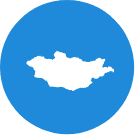- (+976) 80814578, 99095467
- [email protected]

POPULATION
The current population of Mongolia is 3,392,913 as of Monday, September 5, 2022. Mongolia population is equivalent to 0.04% of the total world population. Mongolia ranks number 136 in the list of countries (and dependencies) by population. The population density in Mongolia is 2 per Km2 (5 people per mi2). The total land area is 1,553,560 Km2 67.2 % of the population is urban (2,203,469 people in 2020) The median age in Mongolia is 28.2 years.
...read more
AREA
Mongolia is a landlocked country in eastern Central Asia between Russia and China. The land has a total area of 1,564,120 km². Mongolia is 7th largest country in Asia and the 19th biggest in the world.
...read more
LAND BOUNDARIES
Total border 8,158 km and with Russia 3,485 km and with China 4,676 km. Highest point Khuiten MT peak 4,374 m, lowest point Huh Nuur 560 m.

AVERAGE ALTITUDE
Situated on mountains and high plateaus, it is one of the world's highest countries with elevation averaging 1'580 meters sea level above

TERRAIN
Its remarkable variety of scenery consists largely of upland steppes, semi deserts, and Gobi deserts, although in the west and north forested high mountain ranges alternate with lake- river basins.
...read more
PEOPLE
Northeast Asian ethnic group native to Mongolia. consists of 20 more ethnic groups . Majority is Khalkha Mongolians (86%) those are considered the direct descendants of Chinggis Khaan
...read more
LANGUAGES
Khalkha Mongolian is official language of Mongolia. The other dialects, the number and grouping of which are controversial. Russian, English, Chinese, Korean are widely spoken in the Ulaanbaatar, capital of Mongolia.
...read more
RELIGIONS
Tibetan Mahayana buddhists - 47%, non religious - 39%, semi Muslims - 8%, Shamanic traditions - 3%, Chirstians - 2% Others - 1%

LITERACY RATE
For 2022 was 99.18%, a 0.93% increase from 2010. Mongolia literacy rate for 2010 was 98.26%, a 0.49% increase from 2000.

CLIMATE
Mongolia is high, cold, dry, sunny, windy. It has an extreme continental climate with long, cold winter and short hot summer. Average temperature in warm seasons +26 and cold seasons -24 (november, december, january, february, march)
...read more
POLITICAL SYSTEM
Semi-presidential multi-party representative democracy. Parliamentary republic. President elected for six years. Present President Mr. Khurelsukh Ukhnaa, elected in 2021. Prime Minister appointed by State Great Khural for four years. Present Prime Minister Mr. Oyun-Erdene Luvsannamsrai was appointed in 2020.
...read more
LEGISLATURE
State Great Khural (Parliament), unicameral with 76 members elected for four years. The last election was held in 2020. Executive power is exercised by the Prime Minister, who is the head of government, and the Cabinet. The President is the head of state, but holds limited authority over the executive branch of the government. Legislative power is vested in parliament. The Judiciary is independent of the executive and the legislature.
...read more
JUDICIAL SYSTEM
Mongolian judicial system consists of Constitutional Court , Supreme Court, Province/ aimag and capital city courts, Sub province/soum and district courts.
...read more
STATE STRUCTURE
Mongolia is a unitary state and divided administratively into Provinces /Aimags (21) and a capital city; Aimags are subdivided into soums; soums into communities/bags; and a capital city into districts; districts into sub district/khoroos.
...read more
NATIONAL CURRENCY
Tugrig (MNT) Symbol ₮, about MNT 3'210 TG = USD 1 (by Sep 2022) Official daily Foreign Exchange Rates by Bank of Mongolia

MAIN ENTRY POINTS
Chinggis Khaan International (airport in Ulaanbaatar ), Sukhbaatar (railway station on Mongolian-Russian border) and Zamyn Uud (railway station on Mongolian-Chinese border) by Trans Siberia rail trip. Mongolia has officially 44 border points according to Government resolution and protocol between Mongolia and neighbor 2 countries (Russia and China), 29 border points with Russia, 13 border points with China, 2 Air border crossing to Mongolia
...read more
SEA ACCESS
Closest ocean is the Pacific's Yellow Sea, which is 700 kilometers to the east across northeast China. Tianjin/China (1,344 km) and Nakhodka/Russia (4,037 km).
...read more
PUBLIC HOLIDAYS
December 31- January 1 Western new year, last day of the year. January/February - Mongolian lunar new year (Tsagaan Sar), June 1 - Mother and Child day, July 11-13 National Naadam festival (National holiday), September 6 Republic day of Mongolia, Independence day of Mongolia December 29.
...read more
TIME
There are altogether 3 official timezones in Mongolia, but practically only 2 different times. Countries with a large distance from West to East are often divided into two or more timezones to adjust daytimes to the position of the sun. UTC+8 hours Greenwich Mean Time GMT
...read more
NORMAL WORKING HOURS
Usually two season time followed by private sectors. Summer time 09.00- 18.00 Winter time 08.00-17.00 Lunch break stable at 13.00-14.00 Government organization hours 08.30-17.30 Lunch break 12.30-13.30
...read more
ELECTRIC CURRENT
Mongolia standard voltage is 220 V and the frequency is 50 Hz. You can use your electric appliances in Mongolia, if the standard voltage in your country is in between 220 - 240 V (as is in the UK, Europe, Australia and most of Asia and Africa)
...read more
WEIGHT AND MEASURES:
Metric System the decimal measuring system based on the metre, litre, and gram as units of length, capacity, and weight or mass.

VISA ARRANGEMENTS:
Visa shall be issued by Mongolian embassies and Diplomatic Missions as well as Honorary consuls of Mongolia , or can be obtained at the airport at a cost of USD 50 - 70 but must be accompanied by travel invitation.
...read more
